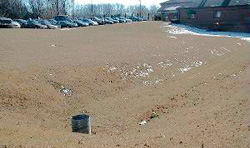Urban Runoff and Floods

Take a bucket of water and pour it over the forest floor. What happens to the water? Most of soaks into the ground without any problem. But take a bucket of water and pour it over a concrete sidewalk or a parking lot, and what happens? It runs off the surface!
Water that runs off of urban surfaces, like sidewalks and parking lots, is called urban runoff. After rainstorms, urban runoff can be a major contributing factor to floods. If urban runoff does not have somewhere to go, it may not take much rain to initiate a flood. The diagram shows how runoff values increase in urban areas because of reduced water infiltration into the ground.
 Depressed basins, like this one, are sometimes constructed in urban areas, near large apartment complexes, and near major streets. Based on what you have just learned about urban runoff, what purpose do you think these basins serve?
Depressed basins, like this one, are sometimes constructed in urban areas, near large apartment complexes, and near major streets. Based on what you have just learned about urban runoff, what purpose do you think these basins serve?
These are sometimes called retention basins or catchment basins. They collect urban runoff and divert it into the ground, helping to reduce the risk of flood from urban runoff.
How could "green rooftops," or rooftops in urban areas covered with growing plants, help reduce flooding by urban runoff?
Plants soak up some of the water and encourage evapotranspiration of some of the water.